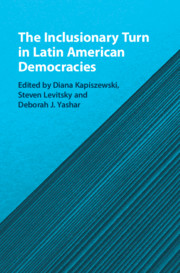Book contents
- The Inclusionary Turn in Latin American Democracies
- The Inclusionary Turn in Latin American Democracies
- Copyright page
- Contents
- Figures
- Tables
- Contributors
- Acknowledgments
- Prologue: Reflections on Two Episodes of Popular Inclusion
- 1 Inequality, Democracy, and the Inclusionary Turn in Latin America
- Part I Extending Social Policy and Participation
- Part II Inclusion and Partisan Representation
- Part III New Party–Society Linkages
- 9 The Politics of Popular Coalitions
- 10 After Corporatism
- 11 Expanding the Public Square
- Part IV Inclusion, Populism, and Democracy
- References
9 - The Politics of Popular Coalitions
Unions and Territorial Social Movements in Post-Neoliberal Latin America (2000–2015)
from Part III - New Party–Society Linkages
Published online by Cambridge University Press: 12 January 2021
- The Inclusionary Turn in Latin American Democracies
- The Inclusionary Turn in Latin American Democracies
- Copyright page
- Contents
- Figures
- Tables
- Contributors
- Acknowledgments
- Prologue: Reflections on Two Episodes of Popular Inclusion
- 1 Inequality, Democracy, and the Inclusionary Turn in Latin America
- Part I Extending Social Policy and Participation
- Part II Inclusion and Partisan Representation
- Part III New Party–Society Linkages
- 9 The Politics of Popular Coalitions
- 10 After Corporatism
- 11 Expanding the Public Square
- Part IV Inclusion, Populism, and Democracy
- References
Summary
At a general level of neoliberal repudiation or expansion of social policies, most post-neoliberal Latin American governments in the 2000s have exhibited similarities. However, coalitions with popular actors have displayed a lot of variation. In order to compare popular sector coalitions the article constructs a framework with two central dimensions: electoral and organizational/interest; in post–import substitution industrialization (ISI), Latin America the latter is composed of both unions and territorial social movements (TSMs). It contends that the region witnessed four types of popular coalitions: electoral (Ecuador and Chile), TSM-based (i.e. made of informal sector-based organizations, Venezuela and Bolivia), dual (i.e. composed of both unions and TSMs, Argentina and Brazil) and union/party-based (Uruguay). The study argues that government–union coalitions are largely accounted for by the relative size of the formal economy, and by the institutional legacies of labor-based parties. Coalitions with informal sector-based organizations were more contingent and rooted in the political activation of these TSMs during the anti-neoliberal struggles of the 1990s.
- Type
- Chapter
- Information
- The Inclusionary Turn in Latin American Democracies , pp. 287 - 326Publisher: Cambridge University PressPrint publication year: 2021
References
- 1
- Cited by

